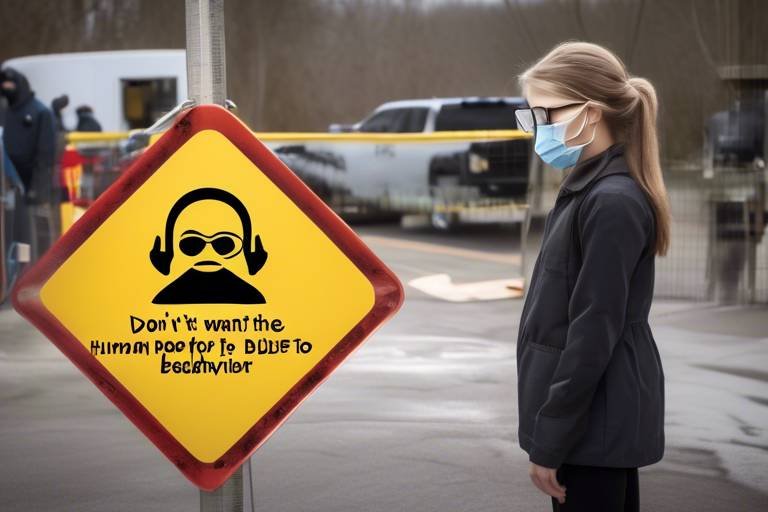The Power of Human Behavior in Implementing Safety Procedures
In today's fast-paced world, the importance of human behavior in implementing safety procedures cannot be overstated. It's often said that "safety is everyone's responsibility," but what does that really mean? At the core of this concept lies the understanding that the way individuals think, feel, and act can significantly influence the effectiveness of safety protocols in any environment. Whether in a manufacturing plant, a hospital, or an office, the decisions made by individuals can either uphold or undermine safety efforts.
Imagine a workplace where every employee is not just aware of safety procedures but actively engaged in them. This level of engagement stems from a deep understanding of the psychological factors that drive compliance. When individuals feel motivated, perceive safety as a priority, and are influenced positively by their peers, they are more likely to adhere to established safety protocols. Conversely, when these factors are absent, compliance can falter, leading to potential hazards that could have been easily avoided.
To illustrate, consider the following scenarios:
| Scenario | Behavior | Outcome |
|---|---|---|
| Team Safety Meeting | Active participation | Increased awareness and compliance |
| Ignoring Safety Gear | Complacency | Higher risk of accidents |
These examples highlight how crucial it is to foster a culture where safety is not just a checkbox but a fundamental part of the workplace ethos. Leaders play an essential role in shaping this culture by modeling safe behaviors and encouraging open communication about safety concerns. When employees see their leaders prioritizing safety, they are more likely to adopt similar attitudes and behaviors.
Moreover, understanding the barriers to safety compliance is just as important as encouraging positive behaviors. Factors such as complacency, lack of training, and a poor organizational culture can create significant hurdles that must be addressed. By identifying these barriers, organizations can implement targeted strategies to enhance safety compliance effectively.
In conclusion, the power of human behavior in safety procedures is undeniable. By focusing on the psychological aspects of compliance, addressing barriers, and fostering a supportive culture, organizations can significantly improve their safety outcomes. After all, when it comes to safety, it's not just about having procedures in place; it's about ensuring that every individual understands their role in maintaining a safe environment.

The Psychology of Safety Compliance
Understanding the psychological factors that drive individuals to comply with safety procedures is essential for creating a culture of safety. At the heart of this understanding lies the concept of motivation. Why do people follow safety protocols? Is it fear of punishment, a genuine concern for their well-being, or perhaps a desire to fit in with their peers? These questions are crucial because they help us unravel the intricate web of human behavior in relation to safety.
One of the key elements influencing safety compliance is perception. How employees perceive risks and safety measures can significantly affect their adherence to protocols. For example, if a worker believes that a particular safety procedure is unnecessary or overly cautious, they may choose to disregard it. This perception can stem from various sources, such as previous experiences, peer influence, or even misinformation. Therefore, it’s vital for organizations to actively shape these perceptions through effective communication and training.
Additionally, the influence of social norms cannot be overstated. Humans are inherently social creatures, and the behaviors of those around us can have a profound impact on our own actions. If safety compliance is viewed as a collective responsibility within a team, individuals are more likely to adhere to safety protocols. Conversely, if they observe peers cutting corners or neglecting safety measures, they may feel justified in doing the same. This highlights the importance of fostering a strong safety culture where safe behaviors are not just encouraged but celebrated.
To illustrate this further, consider the following table that outlines the psychological factors influencing safety compliance:
| Psychological Factor | Description |
|---|---|
| Motivation | The driving force behind an individual's decision to follow safety protocols, which can be intrinsic or extrinsic. |
| Perception | How individuals view risks and safety procedures, which can affect their willingness to comply. |
| Social Norms | The influence of peer behavior on an individual's actions, creating a collective attitude towards safety. |
In summary, the psychology of safety compliance is a multifaceted issue that requires organizations to dig deeper into the minds of their employees. By understanding the motivations, perceptions, and social influences that shape behavior, companies can create more effective safety programs that resonate with their workforce. This, in turn, leads to a safer work environment where compliance is not just a requirement but a shared value.
- What are the main factors influencing safety compliance? The main factors include motivation, perception, and social norms.
- How can organizations improve safety compliance? By understanding psychological factors and fostering a strong safety culture through effective communication and training.
- Why is perception important in safety compliance? Perception shapes how individuals view risks and safety measures, influencing their adherence to protocols.

When it comes to ensuring safety in the workplace, understanding the barriers to compliance is just as crucial as implementing the procedures themselves. Imagine trying to build a strong fortress, but discovering that the very materials you need are either missing or flawed. That's how it feels when organizations overlook the obstacles that hinder safety compliance. These barriers can stem from various sources, including complacency, lack of training, and an ineffective organizational culture.
One of the most significant barriers is complacency. Over time, employees may become desensitized to safety protocols, especially if they perceive their work environment as low-risk. This false sense of security can lead to a dangerous mindset where individuals think, "It won't happen to me." To combat this, organizations need to foster a culture where safety is always top of mind. Regular reminders, engaging safety campaigns, and even gamification can keep safety at the forefront of employees' minds.
Another critical issue is the lack of training. If employees are not adequately trained on safety procedures, they are less likely to follow them. This lack of knowledge creates a gap between the established protocols and actual practices. Organizations should prioritize comprehensive training programs that not only cover the "how-tos" of safety but also the "whys." When employees understand the reasoning behind safety measures, they are more likely to embrace them. For instance, a table summarizing the key training components might look like this:
| Training Component | Description |
|---|---|
| Safety Procedures | Detailed guidelines on how to perform tasks safely. |
| Emergency Response | Steps to take in case of an emergency, including evacuation plans. |
| Risk Assessment | Identifying potential hazards and how to mitigate them. |
Lastly, the organizational culture plays a pivotal role in safety compliance. If safety is not prioritized at the leadership level, it sends a message to employees that it isn't essential. Leaders must not only talk the talk but also walk the walk. This means actively participating in safety meetings, demonstrating safe practices, and making safety a core value of the organization.
To truly address these barriers, organizations need to take a holistic approach. This includes engaging employees in safety discussions, gathering their insights, and making them feel like integral parts of the safety culture. When employees feel valued and heard, they are more likely to comply with safety procedures. In essence, tackling the barriers to safety compliance is not just about enforcing rules but about creating an environment where safety is a shared responsibility.
- What are the most common barriers to safety compliance?
Common barriers include complacency, lack of training, and ineffective organizational culture.
- How can organizations improve safety compliance?
By providing comprehensive training, fostering a proactive safety culture, and engaging employees in safety discussions.
- Why is leadership important in safety compliance?
Leadership sets the tone for safety culture; when leaders prioritize safety, employees are more likely to follow suit.

The Role of Training and Education
In today's fast-paced work environments, the role of training and education in promoting safety compliance cannot be overstated. It’s not just about handing out manuals or conducting a one-time seminar; it's about creating a comprehensive framework that actively engages employees and instills a deep understanding of safety protocols. Think of training as planting a seed in fertile soil; with the right care and attention, it can grow into a robust culture of safety that flourishes across the organization.
One of the most effective ways to ensure that employees grasp the importance of safety procedures is through interactive training methods. These approaches go beyond traditional lectures and engage employees in a manner that resonates with their daily experiences. For instance, utilizing techniques such as simulations and role-playing allows employees to experience potential hazards in a controlled environment. This not only enhances their understanding but also builds their confidence in handling real-life situations. Imagine learning to ride a bike: it’s one thing to hear about balancing and pedaling, but actually doing it is where the magic happens!
Furthermore, continuous learning is essential in keeping safety protocols fresh in the minds of employees. This is where refresher courses come into play. Regularly scheduled updates and training sessions help to reinforce the importance of safety compliance and allow employees to stay informed about any changes in procedures or regulations. Just like how we need to periodically check and update our software, safety knowledge should also be regularly refreshed. Organizations can schedule these refresher courses at intervals that make sense for their operations, ensuring that employees are always equipped with the latest knowledge.
To illustrate the impact of effective training, consider the following table showcasing the correlation between training frequency and incident reduction rates:
| Training Frequency | Incident Reduction Rate (%) |
|---|---|
| One-time training | 10% |
| Quarterly refresher courses | 30% |
| Monthly interactive sessions | 50% |
As shown in the table, organizations that invest in regular and interactive training see a significant decrease in incidents. This highlights the need for a proactive approach when it comes to safety education. Additionally, it’s crucial for training programs to be tailored to the specific needs of the workforce. Different roles may face unique challenges, and training should reflect these realities. By customizing training, organizations can ensure that all employees, regardless of their position, understand the safety procedures relevant to their work.
In conclusion, the role of training and education in safety compliance is multifaceted and vital. By adopting a dynamic approach that includes interactive methods and ongoing learning opportunities, organizations can cultivate a workforce that is not only aware of safety protocols but is also motivated to adhere to them. After all, when employees feel empowered through knowledge, they are more likely to take ownership of their safety and the safety of their colleagues.
- Why is training important for safety compliance? Training equips employees with the knowledge and skills necessary to recognize hazards and adhere to safety protocols, ultimately reducing the risk of incidents.
- How often should refresher courses be conducted? Refresher courses should ideally be conducted quarterly, but the frequency can vary based on the nature of the work and any changes in safety regulations.
- What are some effective training methods? Interactive methods such as simulations, role-playing, and hands-on training are highly effective in engaging employees and improving retention of safety information.

Interactive Training Methods
When it comes to safety training, traditional methods like lectures and PowerPoint presentations can often feel monotonous and disengaging. To truly capture the attention of employees and ensure they absorb critical safety information, can be a game-changer. Imagine a training session where employees are not just passive listeners but active participants who can relate the training content to real-life scenarios. This approach not only enhances engagement but also boosts retention of safety protocols.
One effective interactive method is the use of simulations. These allow employees to experience realistic scenarios in a controlled environment, helping them to understand the importance of safety procedures without the risk of actual harm. For example, in a manufacturing setting, a simulation could involve a mock emergency where employees must respond to a safety incident. This hands-on experience can significantly improve their decision-making skills in real situations.
Role-playing is another dynamic training technique that encourages employees to step into different roles and perspectives. By acting out various scenarios, employees can better understand the implications of their actions on safety. This method fosters empathy and encourages teamwork, as employees learn to rely on one another in high-pressure situations. For instance, a role-playing exercise might involve an employee playing the role of a supervisor addressing a safety violation, which can highlight the importance of communication and accountability.
Moreover, incorporating hands-on activities into safety training can create memorable learning experiences. Whether it's assembling safety equipment or practicing emergency evacuation procedures, these activities allow employees to physically engage with the training material. When employees can touch, feel, and manipulate the tools and processes they are learning about, they are more likely to remember and apply that knowledge when it counts.
To further enhance the effectiveness of these interactive training methods, organizations should consider integrating technology. Virtual reality (VR) and augmented reality (AR) are emerging tools that can provide immersive training experiences. For example, VR can simulate hazardous environments where employees can practice safety protocols without any real-world risks. This technology not only makes training more engaging but also allows for a safe space to learn from mistakes.
In conclusion, by adopting interactive training methods, organizations can cultivate a more engaging and effective safety training environment. These techniques not only improve knowledge retention but also empower employees to take ownership of their safety practices. As we move forward, embracing innovation in training will be key to fostering a culture of safety that resonates with every team member.
- What are interactive training methods? Interactive training methods are engaging techniques that involve active participation from employees, such as simulations, role-playing, and hands-on activities, to enhance learning and retention.
- Why are simulations important in safety training? Simulations provide a realistic environment for employees to practice safety protocols without the risk of real-world consequences, helping them to make better decisions during actual emergencies.
- How can technology enhance safety training? Technologies like virtual reality (VR) and augmented reality (AR) create immersive training experiences, allowing employees to learn in a safe, controlled environment that mimics real-life situations.
- What is the benefit of role-playing in training? Role-playing helps employees understand different perspectives and the impact of their actions on safety, fostering teamwork and enhancing communication skills.

Continuous Learning and Refresher Courses
In the fast-paced world we live in, safety procedures are constantly evolving. This makes continuous learning and refresher courses not just beneficial, but absolutely essential for maintaining a robust safety culture within any organization. Imagine trying to navigate a complex maze without ever updating your map; that’s what it’s like for employees who don’t engage in ongoing training. Regular training sessions ensure that employees are not only aware of the latest safety protocols but also understand the reasons behind these changes.
Furthermore, refresher courses act as a crucial reminder of the importance of safety. They serve to reinforce knowledge and skills that may have faded over time. Consider this: if you learned to ride a bike as a child but never hopped back on for years, would you still feel confident? Probably not! The same principle applies to workplace safety. Regularly scheduled training keeps safety top-of-mind and helps employees feel more competent and confident in their abilities to adhere to safety protocols.
To effectively implement continuous learning, organizations should consider a variety of training formats. Here are some key methods:
- Online Modules: These allow employees to learn at their own pace and can be revisited whenever needed.
- In-Person Workshops: Hands-on sessions can be particularly effective for demonstrating safety equipment and emergency procedures.
- Peer Learning: Encouraging employees to share experiences and lessons learned can foster a collaborative environment focused on safety.
Additionally, it’s important for organizations to regularly assess the effectiveness of their training programs. This can be achieved through feedback mechanisms, such as surveys or informal discussions, which help identify areas needing improvement. By creating a culture of continuous feedback, companies can adapt their training programs to better meet the needs of their employees.
In conclusion, continuous learning and refresher courses are vital components of a successful safety strategy. They not only keep employees informed but also empower them to take ownership of their safety responsibilities. By investing in ongoing education, organizations can create a safer workplace where everyone feels equipped to handle potential hazards.
Q: Why are refresher courses necessary?
A: Refresher courses help reinforce safety knowledge, ensuring that employees remain aware of the latest protocols and practices.
Q: How often should refresher courses be conducted?
A: It’s recommended to conduct refresher courses at least annually, but more frequent sessions may be necessary depending on the industry and specific safety requirements.
Q: What are effective methods for continuous learning?
A: Effective methods include online modules, in-person workshops, and peer learning opportunities that encourage collaboration and knowledge sharing.

The Influence of Leadership on Safety Culture
Leadership is more than just a title; it’s a commitment to fostering a culture where safety is paramount. When leaders actively demonstrate safe behaviors, they set a powerful example for their teams. Imagine a ship navigating through stormy seas; the captain's actions can either instill confidence or create chaos. Similarly, in the workplace, leaders who prioritize safety create an environment where employees feel secure and valued. This commitment to safety not only enhances compliance but also boosts morale and productivity.
One of the primary ways leaders influence safety culture is through communication. Open lines of communication encourage employees to voice their concerns and share their experiences. When leaders are approachable and actively listen, it cultivates a sense of trust. Employees are more likely to report unsafe conditions or near-misses when they know their input is valued. This two-way communication loop is crucial for identifying potential hazards and improving safety protocols.
Moreover, leaders need to recognize that their actions speak louder than words. If a leader emphasizes safety but neglects to follow safety protocols themselves, it sends a conflicting message. This incongruence can lead to a culture of complacency where employees may feel that safety is merely a suggestion rather than a requirement. To combat this, leaders should engage in regular safety training and participate in safety drills alongside their teams. This not only reinforces the importance of safety but also demonstrates a shared commitment to a safe working environment.
Another vital aspect of leadership in safety culture is recognition and reward. Acknowledging employees who consistently adhere to safety procedures can motivate others to follow suit. Consider implementing a recognition program that highlights individuals or teams who exemplify outstanding safety practices. This not only boosts morale but also reinforces the idea that safety is everyone's responsibility. When employees see their peers being rewarded for safe behavior, it creates a ripple effect, encouraging others to prioritize safety as well.
It’s also essential for leaders to provide the necessary resources and training to support safety initiatives. This includes ensuring that employees have access to the right tools, equipment, and information to perform their jobs safely. Inadequate training or resources can lead to frustration and increased risk of accidents. By investing in comprehensive safety training and providing ongoing support, leaders demonstrate their commitment to employee well-being and safety.
Lastly, the influence of leadership on safety culture extends beyond the workplace. Leaders should advocate for safety not only within their organizations but also in the wider community. This can be achieved through participation in safety awareness campaigns, partnerships with local organizations, and by sharing best practices. Such actions not only enhance the organization’s reputation but also contribute to a broader culture of safety.
- How can leaders effectively communicate safety policies?
Leaders should use clear, concise language and ensure that safety policies are easily accessible. Regular meetings and training sessions can help reinforce these messages. - What role does feedback play in improving safety culture?
Feedback is crucial as it allows leaders to understand the concerns and suggestions of employees, leading to better safety practices and policies. - How can recognition programs enhance safety compliance?
Recognition programs motivate employees to adhere to safety procedures by rewarding those who demonstrate safe practices, thus promoting a culture of safety.

Feedback Mechanisms for Improvement
Implementing feedback mechanisms is not just a checkbox exercise; it's a fundamental part of enhancing safety compliance in any organization. When we talk about safety procedures, we often think of strict guidelines and protocols, but what truly makes these procedures effective is the input from the very individuals who are expected to follow them. Imagine a ship sailing smoothly; it’s not just the captain at the helm, but also the crew communicating about the conditions of the sea. Similarly, in a workplace, creating avenues for feedback can help identify potential hazards and areas for improvement that may not be visible from the top down.
One of the most effective ways to gather feedback is through regular surveys and assessments. These tools can be designed to gauge employee perceptions of safety practices, their comfort level in reporting unsafe conditions, and suggestions for improvement. It's essential to create a culture where employees feel safe to express their thoughts without fear of repercussions. When workers know their voices matter, they're more likely to share valuable insights that can lead to significant safety enhancements.
Another critical aspect of feedback mechanisms is post-incident reviews. After any safety incident, conducting a thorough review can provide insights into what went wrong and how similar incidents can be prevented in the future. This process should include input from all parties involved, fostering a sense of ownership and accountability. By analyzing these incidents collaboratively, organizations can develop more robust safety protocols that address the root causes rather than just the symptoms.
Let’s not forget the power of open communication channels. Establishing a system where employees can voice their concerns or suggestions in real-time can be a game-changer. This can take various forms, such as suggestion boxes, dedicated safety committees, or regular safety meetings. When employees see that their feedback leads to tangible changes, it reinforces the importance of their contributions and encourages a proactive approach to safety.
Additionally, organizations can utilize technology to enhance feedback mechanisms. For instance, mobile apps can be developed to allow employees to report safety hazards instantly, providing a quick and efficient way to address issues. This real-time feedback loop not only helps in immediate hazard mitigation but also builds a culture of continuous improvement.
In summary, effective feedback mechanisms are essential for improving safety compliance. They not only empower employees to take an active role in their safety but also provide valuable insights that can lead to enhanced safety practices. By fostering a culture of open communication and continuous feedback, organizations can ensure that their safety protocols evolve and adapt to meet the ever-changing landscape of workplace safety.
- Why are feedback mechanisms important for safety compliance?
Feedback mechanisms help identify weaknesses in safety procedures and promote a culture of continuous improvement, ensuring that employees feel valued and engaged in safety practices. - How can organizations encourage employees to provide feedback?
Creating a safe environment for open communication, utilizing anonymous surveys, and actively responding to feedback can encourage employees to share their thoughts and concerns. - What role does technology play in feedback mechanisms?
Technology can facilitate real-time reporting of safety issues through mobile apps and online platforms, making it easier for employees to communicate hazards and suggestions.

Encouraging Open Communication
In any organization, encouraging open communication is not just a nice-to-have; it's a fundamental necessity for fostering a robust safety culture. When employees feel comfortable sharing their thoughts and concerns, it creates an environment where safety can thrive. Imagine a workplace where every voice matters, where employees are not just following procedures but actively contributing to the evolution of safety practices. This is the kind of culture that can significantly reduce accidents and enhance overall safety compliance.
One effective way to promote open communication is by establishing regular safety meetings. These gatherings provide a platform for employees to discuss safety issues, share experiences, and suggest improvements. However, it's crucial that these meetings are not just formalities. They should be engaging and allow for honest dialogue. Leaders can encourage participation by asking open-ended questions and genuinely considering the feedback provided. This approach not only empowers employees but also helps management identify potential safety hazards that may not be immediately visible.
Another strategy involves creating anonymous feedback channels. Sometimes, employees may hesitate to voice their concerns due to fear of retaliation or judgment. By allowing them to submit feedback anonymously, organizations can gather more honest insights. This could be done through suggestion boxes or digital platforms where employees can share their thoughts without revealing their identities. It’s essential for management to act on this feedback and communicate any changes made as a result. When employees see that their input has led to tangible improvements, it reinforces the value of open communication.
Moreover, training programs should emphasize the importance of communication in safety procedures. Employees should be equipped with the skills to express their concerns effectively and encouraged to do so. Role-playing scenarios can be a useful tool here, allowing employees to practice how to approach safety discussions with their peers and supervisors. This kind of training not only builds confidence but also cultivates a shared responsibility for safety within the team.
Ultimately, fostering open communication requires a commitment from leadership. Leaders should model the behavior they wish to see. When management openly discusses safety concerns and actively seeks employee feedback, it sends a powerful message about the importance of safety. It's like planting a seed; with the right nurturing, it can grow into a strong tree of safety culture that benefits everyone in the organization.
In conclusion, encouraging open communication is crucial for enhancing safety compliance within any organization. By creating an environment where employees feel safe to express their thoughts and concerns, organizations can not only improve their safety practices but also build a more cohesive and engaged workforce. The result? A safer workplace for everyone.
- Why is open communication important in safety procedures?
Open communication allows employees to voice concerns, share experiences, and contribute to safety improvements, leading to a safer workplace. - How can organizations encourage open communication?
Organizations can encourage open communication by holding regular safety meetings, implementing anonymous feedback channels, and providing training on effective communication. - What role does leadership play in promoting open communication?
Leadership sets the tone for communication culture. When leaders model open dialogue and actively seek feedback, it encourages employees to do the same. - What are some effective methods for gathering employee feedback?
Methods include regular safety meetings, anonymous suggestion boxes, and digital platforms for feedback submission.

Utilizing Data for Safety Enhancements
In today's fast-paced world, data-driven decision-making has become a cornerstone of effective safety management. Organizations that harness the power of data can not only identify potential hazards but also implement proactive measures to mitigate risks. By analyzing incident reports, safety audits, and employee feedback, companies can gain valuable insights into their safety procedures and make informed adjustments. This process is akin to using a compass in uncharted territory; it guides organizations towards safer practices and environments.
One of the key advantages of utilizing data for safety enhancements is the ability to uncover trends and patterns that may not be immediately apparent. For example, if an organization notices a spike in incidents related to a specific task or equipment, it can investigate the underlying causes. This might involve examining the training provided, the equipment's condition, or even the work environment. By addressing these factors, organizations can effectively reduce the likelihood of future incidents.
Additionally, organizations can use data to benchmark their safety performance against industry standards or competitors. This comparative analysis can reveal areas where a company excels or, conversely, where it may fall short. By understanding where they stand in relation to others, organizations can set realistic and achievable safety goals. For instance, if the data shows that the average incident rate in a particular industry is lower than theirs, it can motivate the organization to enhance its safety protocols and training.
To effectively utilize data for safety enhancements, organizations should consider implementing a structured approach. This could include:
- Regular Data Collection: Establishing a routine for collecting safety data, such as incident reports and employee feedback, ensures that the information is current and relevant.
- Data Analysis: Employing tools and techniques to analyze the collected data can help identify trends and root causes of incidents.
- Actionable Insights: Transforming data analysis into actionable insights is crucial. This means not just identifying issues but also developing strategies to address them.
- Monitoring and Evaluation: After implementing changes based on data insights, organizations should monitor the outcomes to evaluate the effectiveness of those changes.
Moreover, leveraging technology can enhance the data utilization process. For instance, organizations can use software solutions designed for safety management that integrate data collection, analysis, and reporting. These systems can automate processes, making it easier to track safety metrics and generate reports that highlight areas needing attention.
Ultimately, the goal of utilizing data for safety enhancements is to create a continuous improvement cycle. By regularly assessing safety procedures and making data-informed adjustments, organizations can foster a culture of safety that not only protects employees but also enhances overall productivity and morale. It's about moving from a reactive approach—where safety measures are only implemented after incidents occur—to a proactive strategy that anticipates and mitigates risks before they escalate.
Q: How can organizations start using data for safety enhancements?
A: Organizations can begin by establishing a routine for collecting safety data, analyzing it for trends, and implementing changes based on actionable insights.
Q: What types of data should be collected for safety improvements?
A: Key data types include incident reports, near-miss reports, safety audit results, employee feedback, and training effectiveness assessments.
Q: How often should safety data be reviewed?
A: Safety data should be reviewed regularly, ideally on a monthly or quarterly basis, to ensure that any emerging trends are addressed promptly.
Q: Can technology aid in data collection and analysis?
A: Yes, various software solutions are available that help automate data collection, analysis, and reporting, making it easier for organizations to track safety metrics.
Frequently Asked Questions
- What is the importance of human behavior in safety procedures?
Human behavior plays a critical role in the effectiveness of safety procedures. Understanding how individuals perceive risks and comply with safety protocols can lead to improved safety outcomes. When organizations focus on the psychological aspects of compliance, they can foster a culture that prioritizes safety.
- What psychological factors influence safety compliance?
Several psychological factors drive safety compliance, including motivation, perception of risks, and social norms. When employees feel motivated and perceive safety as a shared value, they are more likely to adhere to safety procedures. Recognizing these factors can help organizations design better safety programs.
- What are common barriers to safety compliance?
Common barriers to safety compliance include complacency, lack of training, and an unsupportive organizational culture. These obstacles can hinder employees' willingness to follow safety protocols. By identifying and addressing these barriers, organizations can enhance adherence to safety measures.
- How can training improve safety compliance?
Effective training is essential for promoting safety compliance. Programs that resonate with employees and emphasize the importance of safety can significantly improve adherence to procedures. Utilizing interactive methods such as simulations and role-playing can further enhance engagement and retention of safety information.
- Why is continuous learning important for safety?
Continuous learning, including refresher courses, is vital for maintaining safety awareness among employees. Regular training updates help keep safety procedures fresh in their minds, ensuring they remain vigilant and compliant with safety protocols over time.
- How does leadership influence safety culture?
Leadership plays a pivotal role in shaping an organization's safety culture. Leaders who model safe behaviors and prioritize safety create an environment where employees feel encouraged to follow safety protocols. Their commitment can significantly impact overall safety compliance.
- What are effective feedback mechanisms for safety improvement?
Implementing feedback mechanisms allows organizations to assess the effectiveness of their safety procedures. Encouraging open communication and gathering input from employees can help identify areas for improvement, leading to enhanced compliance and safety outcomes.
- How can data be utilized for safety enhancements?
Data-driven decision-making is crucial for improving safety outcomes. Organizations can leverage incident reports and safety audits to inform procedural adjustments. By analyzing this data, they can identify trends and areas needing attention, ultimately enhancing overall safety compliance.



















